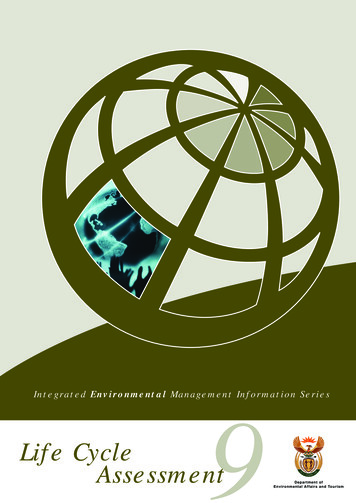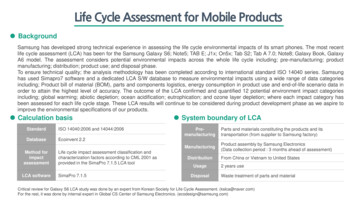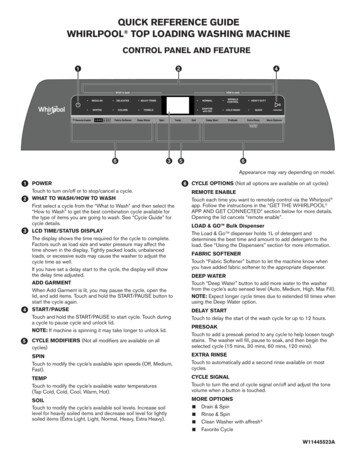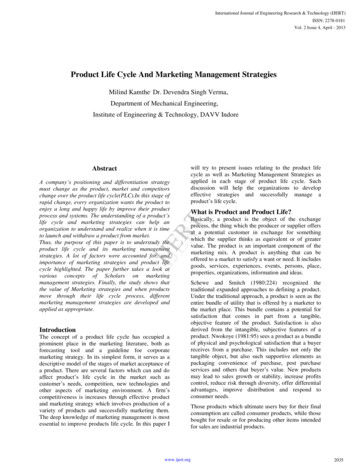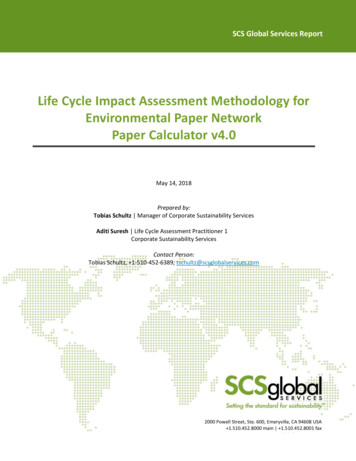
Transcription
SCS Global Services ReportLife Cycle Impact Assessment Methodology forEnvironmental Paper NetworkPaper Calculator v4.0May 14, 2018Prepared by:Tobias Schultz Manager of Corporate Sustainability ServicesAditi Suresh Life Cycle Assessment Practitioner 1Corporate Sustainability ServicesContact Person:Tobias Schultz, 1-510-452-6389, tschultz@scsglobalservices.com2000 Powell Street, Ste. 600, Emeryville, CA 94608 USA 1.510.452.8000 main 1.510.452.8001 faxwww.SCSglobalServices.com
Life Cycle Impact Assessment Methodology for EPN Paper Calculator v4.0May 14, 2018Table of ContentsList of Figures . ivList of Tables . viTerminology Used in this Report . viiAcronyms . x1Introduction . 22Goal and Scope of the Study . 2Key Limitations and Assumptions . 7Assumptions . 7Limitations. 73Methodology. 8Functional Unit . 8System Boundary . 9Designating Recycled Content in Paper: . 10User Inputs for Tissue Paper Grade: . 10Allocation Procedures . 12Allocation Method for Recycled Fiber Inputs in Recycled Papers . 13Data Requirements . 13Approach for retrieving data from the RISI Mill Asset Database . 17Calculation of toxic air emissions data. 22Use of Ecoinvent and USLCI Datasets . 22Waste output data per metric ton of paper- BOD, COD, TSS and Solid Waste . 22LCI Analysis Summary . 24Accounting for Biogenic Carbon Flows . 29LCIA Methodology Summary . 30Biotic/Abiotic Resource Depletion Indicators . 30Climate System Impacts . 32Ocean Ecosystem Impacts . 34Terrestrial and Freshwater Ecosystem Impacts (from Emissions) . 35Impacts on Terrestrial and Freshwater Ecosystems (from Land Use and Conversion) . 37Human Health Impacts (from Chronic Exposure to Hazardous Chemicals). 42May 2018 SCS Global ServicesPage ii of xii
Life Cycle Impact Assessment Methodology for EPN Paper Calculator v4.0May 14, 2018Additional Environmental Information . 44Factors Applied to Determine Equivalencies for Impact Indicators . 46Sensitivity Analysis for Recycled Papers by Assigned Credit for Diversion of Wastepaper fromLandfill . 494Conclusions . 54Appendix: Dispersion Models Used to Assess Regional Acidification, Ground Level Ozone and PM2.5Impacts. 55A.1 Regional Acidification . 57A.2 Ground Level Ozone Exposures . 58A.3 PM2.5. 59May 2018 SCS Global ServicesPage iii of xii
Life Cycle Impact Assessment Methodology for EPN Paper Calculator v4.0May 14, 2018List of FiguresFigure 1. The system boundary depicts the key inputs, outputs and key processing steps associated with100% virgin paper grades production from cradle-to-grave. . 11Figure 2. The system boundary depicts the key inputs, outputs and key processing steps associated with100% recycled paper grades production from cradle-to-grave. . 12Figure 3. Data collection for key processes (1 through 7) and flows (A through G) relative to theproduction of 1 metric ton of paper. . 14Figure 4. Screenshot of format of data used to classify the mills as Integrated and Non-Integrated. Therows highlighted in yellow are examples of Non-integrated mills as they purchase 100% of the pulp.Note that the mill names and the table header names have been modified due to RISI’s purchaserestrictions. Data here is strictly for demonstrative purpose only. . 17Figure 5. Screenshot of format of data used to classify mills with 100% recycled fiber inputs. The rowshighlighted in yellow are examples of mills using only recovered fiber inputs (values indicated in red).Note that the mill names and the table header names have been modified due to RISI’s purchaserestrictions. Data here is strictly for demonstrative purpose only. . 18Figure 6. Screenshot of format of data used to classify mills with 100% virgin fiber inputs. The rowshighlighted in yellow are examples of mills using only virgin fiber inputs (values indicated in red). Notethat the mill names and the table header names have been modified due to RISI’s purchase restrictions.Data here is strictly for demonstrative purpose only. . 18Figure 7. Screenshot of format of data used to classify mills with mixed fiber inputs. The rowshighlighted in yellow are examples of mills using mixed fiber inputs (values indicated in red). Note thatthe mill names and the table header names have been modified due to RISI’s purchase restrictions. Datahere is strictly for demonstrative purpose only. 18Figure 8. The above figure illustrates the classification of pulp and paper mills in the RISI Mill AssetDatabase. 100% virgin and 100% recycled paper grades are produced in non-integrated paper mills(indicated in orange color) and integrated paper mills (indicated in purple color). Virgin pulp mills(indicated in red color) supply virgin pulp to non-integrated and integrated paper mills producing 100%virgin paper products. Similarly, recycled pulp mills (indicated in green color) supply recycled pulp tonon-integrated and integrated paper mills producing 100% recycled paper products. Woody inputs arerequired during virgin pulp production as well as in integrated paper mills producing virgin paperproducts. Wastepaper inputs are required for recycled pulp production as well as in integrated millsproducing recycled paper products. . 19Figure 9. Snapshot of “Above and below ground carbon in live trees” dataset representing the forestcarbon density for the states of California, Oregon, Washington, Wisconsin and Maine from the USForest Services website. 39Figure 10. The figure represents the terrestrial ecoregions across North America, as defined by WWFWildfinder database. The red spots represent the location of the pulp and paper mills. . 41May 2018 SCS Global ServicesPage iv of xii
Life Cycle Impact Assessment Methodology for EPN Paper Calculator v4.0May 14, 2018Figure 11. Sensitivity analysis is explored for the GHG Impact indicator for 100% Recycled Papers, byproviding a credit for the amount of waste paper diverted from the landfill. For the purpose ofcomparison, results for 100% Virgin Paper and 100% Recycled Paper (without the credit) are illustratedin the chart. . 51Figure 12. Sensitivity analysis is explored for the Ocean Acidification indicator for 100% Recycled Papers,by providing a credit for the amount of waste paper diverted from the landfill. For the purpose ofcomparison, results for 100% Virgin Paper and 100% Recycled Paper (without the credit) are illustratedin the chart. . 52Figure 13. Sensitivity analysis is explored for the Solid Waste indicator for 100% Recycled Papers, byproviding a credit for the amount of waste paper diverted from the landfill. For the purpose ofcomparison, results for 100% Virgin Paper and 100% Recycled Paper (without the credit) are illustratedin the chart. . 53Figure 14. Example concentration plume from single emission source (Source:http://www.arl.noaa.gov/HYSPLIT info.php.). 57Figure 15. Soil sensitivity class based on the HWSD for North America. Soils of sensitivity class 1 (mostsensitive) through sensitivity class 4 are classified, while soils of class 5 are not classified. . 58May 2018 SCS Global ServicesPage v of xii
Life Cycle Impact Assessment Methodology for EPN Paper Calculator v4.0May 14, 2018List of TablesTable 1. Types of paper grades included in the scope of the Paper Calculator v4.0 and the number ofmills included in this assessment to present North American average results. . 3Table 2. List of indicators presented as outputs in the Paper Calculator v4.0. . 4Table 3. Default grammage values by tissue paper grade. . 9Table 4. Data points and data sources used for modeling 100% virgin papers and 100% recycled papersbased on Figure 3. . 15Table 5. Classification of mills by paper grade in the RISI Mill Asset Database based on Figure 8. . 20Table 6. Datasets used to determine the amount of BOD, COD, TSS and solid waste outputs duringpapermaking. (Note: “cut-off, U” refers to the classification of datasets used to model the paper gradesin the Ecoinvent v3.3 LCA database. Letters US, CA and QC denote the region represented by thedataset. “US” refers to United States”, “CA” refers to Canada” and “QC” refers to Quebec province inCanada). . 23Table 7. List of background datasets used to model major inputs (see Figure 3) required for productionof 14 paper grades.The representativeness and materiality of the data has been addressed qualitativelyusing the acronyms H High, M Medium and L Low. . 25Table 8. GWP-20 values used for evaluating GHG/Climate Change Impacts indicator. . 33Table 9. M-CFs for 100% virgin and 100% recycled paper grades used to model North American averageresults for acidifying emissions/regional acidification indicator. . 36Table 10. M-CFs for 100% virgin and 100% recycled paper grades used to model North American averageresults for ground level ozone indicator. . 42Table 11. M-CFs for 100% virgin and 100% recycled paper grades used to model North American averageresults for PM2.5 Impacts. . 43Table 12. Equivalency Factors applied for Paper Calculator v4.0 Indicators. . 46May 2018 SCS Global ServicesPage vi of xii
Life Cycle Impact Assessment Methodology for EPN Paper Calculator v4.0May 14, 2018Terminology Used in this ReportTermBackground UnitProcesses (orBackground System)Biotic ResourceBlack CarbonBlack LiquorCategory IndicatorCore ImpactCategoryCradle-to-gateCradle-to-graveData edance ofThresholdFiber BasketForegone GrowthForest Analysis UnitForest InventoryForest TypeForestlandFreshwaterEcosystemFunctional UnitImpactDefinitionUnit processes not specific to the product system under study, including those processes upstreamand/or downstream where many suppliers are involved.A resource derived recently from living biomass.The light-absorbing component of carbonaceous aerosols. Black carbon contributes to roughly 1W/m2 of global radiative forcing, and is the second most important forcing agent after carbondioxide.A by-product of wood pulping, which can be combusted to generate electricity in integrated virginpulp and paper mills.Quantifiable representation of an impact category [Ref. ISO-14044] (Also referred to as “ImpactCategory Indicator,” or simply, “Indicator.”)An impact category in which at least one unit process in the product system under studycontributes measurably to observed midpoints or endpoints in the stressor-effects network.Defined independently by product system.A scope which includes the life cycle stages from raw material extraction through production of aproduct.A scope which includes all life cycle stages from raw material extraction through end-of-life.Characteristics of data that relate to their ability to satisfy stated requirements [Ref: ISO 14044].Average deviation in overall ecological conditions in a terrestrial ecoregion biome, when comparedto undisturbed conditions (i.e., unaffected by anthropogenic activities since the pre-industrial era)and fully disturbed conditions (i.e., representing maximally disturbed areas) in an area within thesame biome ecoregion type.See ImpactSystem of physical, chemical, radiological, and biological processes for a given impact category,linking stressor(s) to midpoints and to category endpoints. [Based on ISO 14044]For a given impact category, represents the surpassing of a threshold (defined below).Region supplying pulpwood to each dissolving pulp mill.The forest growth avoided as a result of ongoing harvests. In terms of carbon or forest condition,this is the “opportunity cost” associated with ongoing harvests.An area of timberland used to represent forest ecosystem impacts resulting from forestryoperations within a region.An accounting of trees and their related characteristics of interest over a well-defined land area.A classification of forest land based on the species that form a plurality of live-tree basal-areastocking. 1Land that is at least 10 percent stocked with trees of any size, or that formerly had such tree coverand is not currently developed for a nonforest use. The minimum area for classification of forestland is one acre. The components that make up forest land are timberland and all noncommercialforest land. 2An interconnected biotic community, including watercourses, lakes, wetlands, and adjacent riparianareas, within specific watershed boundaries, defined by: salinity; turbidity; water temperature;sedimentation rates; sediment size distribution; flow rates; depths; channel contours; hydrologyand hydraulics; water quality; watershed area; tributary areas; stream lengths; presence of largewoody debris; riparian canopy cover; riparian zone vegetative species composition; climate; andgeology.Quantified performance of a product system for use as a reference unit. [Ref. ISO 14044].An effect on human health or the environment.1USFS. Northeastern Forest Inventory & Analysis, Methodology: Common Definitions Used in FIA.http://www.fs.fed.us/ne/fia/methodology/def ah.htm2 Ibid.May 2018 SCS Global ServicesPage vii of xii
Life Cycle Impact Assessment Methodology for EPN Paper Calculator v4.0May 14, 2018TermImpact CategoryImpact GroupImpact ProfileIndicatorInputKey Unit Process orKey Unit OperationLCIA ProfileLife CycleLife CycleAssessment (LCA)Life Cycle ImpactAssessment (LCIA)Life CycleInterpretationLife Cycle Inventory(LCI)MidpointCharacterizationFactor (M-CF)MidpointNodeOrganic CarbonOutputPotency PotentialCharacterizationFactor (PP-CF)ProductProduct SystemWoody InputsRadiative ForcingReceivingEnvironmentResource DepletionRoundwoodDefinitionClass representing environmental issues of concern to which life cycle inventory analysis resultsmay be assigned [Ref: ISO-14044]. The issues of concern are represented in a distinctenvironmental mechanism, which can be modeled with a stressor-effects network made up ofobservable stressors, midpoints, and endpoints.Impact categories with similar endpoints and environmental mechanisms.See LCIA Profile. (Also referred to as “profile” or “eco-profile.”)See Category Indicator.Product, material or energy flow that enters a unit process. [Ref. ISO 14044].A unit process (or unit operation) contributing over 10% to any indicator result.A discrete compilation of the LCIA category indicator results for different impact categories. [Ref:ISO 14044, §4.4.2.5]Consecutive and interlinked stages of a product system, from raw material acquisition or generationfrom providing environment to final disposal.Compilation and evaluation of the inputs, outputs and the environmental and human healthimpacts of a product system throughout its life cycle. [Based on ISO 14044]Phase of life cycle assessment aimed at determining the magnitude and significance of theenvironmental and human health impacts for a product system throughout the life cycle of theproduct. [Based on ISO 14044]Phase of life cycle assessment in which findings of either the inventory analysis or the impactassessment, or both, are evaluated in relation to the defined goal and scope in order to reachconclusions and recommendations. [Ref: ISO 14044]Phase of a life cycle assessment involving the compilation and quantification of inputs and outputsfor a product throughout its life cycle. [Ref: ISO 14044]A factor which characterizes the actual effect on the receiving environment of emissions, resourceuses, or land uses. Multiplied with Potency Potential Characterization Factors (PP-CFs) to calculateresults.A distinct node in a stressor-effects network representing an observed chemical, physical,radiological or biological impact that is linked to the final category endpoint(s).The modeled representation of an observed chemical, physical, radiological, or biological impactwithin a distinct stressor-effects network.The scattering component of carbonaceous aerosols, these emissions lead to a modest coolingeffect globally due to their negative radiative forcing.Product, material or energy flow that leaves a unit process. [Ref. ISO 14044].A factor which characterizes the relative potency of emissions, resource uses, or land uses, incausing impacts. Multiplied with Midpoint Characterization Factors (M-CFs) to calculate results.Any good or service. [Ref: ISO 14025].Collection of unit processes with elementary and product flows, performing one or more definedfunctions, and which models the life cycle of a product. [Ref. ISO 14044]Includes roundwood, chips, and other mill residues used as inputs to produce pulp in pulping mills.Expresses the change in energy in the atmosphere due to GHG emissions. It is expressed in wattsper square meter (W/m2) or the rate of energy change per unit area of the globe measured at thetop of the atmosphere.The environment affected by stressor(s) including emissions, land use, or wastes.The degree to which the net consumption of a resource results in a reduction in its reserve base,taking into account the extent of reserve base and projected consumption.A length of cut tree generally having a round cross-section, such as a log or bolt.33Stokes, Bryce J.; Ashmore, Colin; Rawlins, Cynthia L.; Sirois, Donald L. 1989. Glossary of Terms Used in Timber Harvesting andForest Engineering. Gen. Tech. Rep. SO-73. New Orleans, LA: U.S. Dept. of Agriculture, Forest Service, Southern ForestExperiment Station. p.33May 2018 SCS Global ServicesPage viii of xii
Life Cycle Impact Assessment Methodology for EPN Paper Calculator v4.0May 14, 2018TermSensitivity strialEcoregion/ ForestEcoregionThresholdTimberlandTime HorizonTonTon-kilometerUndisturbedReference AreaUnit ProcessWatershed or HydrobasinWetland EcosystemDefinitionSystematic procedures for estimating the effects of the choices made regarding methods and dataon the outcome of a study. [Ref. ISO-14044]Any life cycle inventory input, output, or other activity associated with a unit process that can belinked to observable midpoints and endpoints in a defined environmental mechanism.A model used to represent an environmental mechanism, beginning with stressor(s) associated witha given unit process, which lead to midpoint(s) and eventually category endpoint(s) within animpact category. (Also referred to as “Cause-Effect Chain”)See product system.A biotic community in a specific terrestrial area, which is defined by conditions such as prevailingvegetation structure, leaf types, plant spacing, vegetative species composition, vegetativecompositional structure, vegetative age structure, presence of large living trees and snags (ifrelevant), presence of biomass (above and below ground), soil conditions, connectivity, landscapeheterogeneity, fragmentation, climate, and topography.A recognized environmental condition that, when exceeded, is linked to nonlinear changes inimpacts to environment or human health.Forest land producing or capable of producing crops of industrial wood (more than 20 cubic feet peracre per year) and not withdrawn from timber utilization (formerly known as commercial forestland).4A specified timeframe.Metric ton (1,000 kilograms or 2,200 pounds).Unit of transport, representing one metric ton transported one kilometerArea of forest/other wooded land against which measurements of ecological conditions in a ForestAnalysis Unit (FAU) are compared. The Undisturbed Reference Area is chosen to be representativeof the forest ecosystem in the Forest Analysis Unit against which it is compared, if significant humaninterventions were absent for a time period sufficient for mature forest ecosystem characteristicsto become established. The Undisturbed Reference Area should: Include an area which has not been subject to significant human interventions (i.e., logging,intensive hunting, non-timber extraction, agriculture, mining, or other activities) for thelongest time possible, which is not less than 80 years. Be located in a region with similar climate, elevation, rainfall, and soil conditions, to the forestecosystem in the Forest Analysis Unit against which it is compared. Be located as close as possible to the Forest Analysis Unit against which it is compared, andnever farther away than 800 kilometers. Include the largest possible contiguous area in the region satisfying these requirements, whichis no less than 5,000 hectares.Smallest element considered in the life cycle assessment for which input and output data arequantified [Ref: ISO 14044].The area of land where all of the water that falls in it and drains off of it goes into the same place.5A biotic community in a specific wetland, defined by: salinity; turbidity; water quality;sedimentation rates; sediment size distribution; flow rates; depths; hydrology; vegetative cover;plant structure (if plants are present); bottom particle composition and structure; channelconnectivity; channel complexity; tidal action (for saltwater wetlands); wave action (for saltwaterwetlands); and climate.4USFS. Northeastern Forest Inventory & Analysis, Methodology: Common Definitions Used in FIA.http://www.fs.fed.us/ne/fia/methodology/def qz.htm5 USGS: What is a Watershed? http://water.usgs.gov/edu/watershed.htmlMay 2018 SCS Global ServicesPage ix of xii
Life Cycle Impact Assessment Methodology for EPN Paper Calculator v4.0May 14, WMWhN2ONOxNPRIO3PCRPMPM2.5ppbBiochemical Oxygen DemandCarbonCanadaCharacterization FactorMethaneCarbon DioxideChemical Oxygen DemandEquivalentForest Analysis UnitSquare FeetGreenhouse GasGround Level OzoneGlobal Warming PotentialCarbonic AcidHazardous Air PollutantHybrid Single Particle Lagrangian Integrated TrajectoryIntergovernmental Panel on Climate ChangeInternational Union for the Conservation of NatureKilowattLife Cycle AssessmentLife Cycle InventoryLife Cycle Impact AssessmentMetersSquare MeterCubic MeterMidpoint Characterization FactorMegajouleMillion British thermal unitsMunicipal Solid WasteMegawatt-hoursNitrous OxideNitrogen OxidesNational Pollutant Release InventoryOzoneProduct Category RuleParticulate MatterParticulate Matter 2.5Parts Per BillionMay 2018 SCS Global ServicesPage x of xii
Life Cycle Impact Assessment Methodology for EPN Paper Calculator v4.0May 14, otency Potential Characterization FactorRadiative ForcingRest of the World/GlobalSulfur DioxideToxic Release InventoryTotal Reduced SulfurTotal Suspended SolidsUnited Nations Environment ProgramUnited Nations Framework Convention on Climate ChangeUndisturbed Reference AreaUnited StatesVolatile Organic CompoundWorld Health OrganizationYearMay 2018 SCS Global ServicesPage xi of xii
Life Cycle Impact Assessment Methodology for EPN Paper Calculator v4.0May 14, 2018This page left intentionally blank.May 2018 SCS Global ServicesPage xii of xii
Life Cycle Impact Assessment Methodology for EPN Paper Calculator v4.0May 14, 20181 IntroductionThe Paper Calculator, originally launched in 2005 by the Environmental Defense Fund (EDF), is aninnovative web-based tool that is publicly available and allows users to compare the environmentalimpacts of different paper choices using a methodology based in life cycle assessment (LCA). LCA is atool that can be used to assess the environmental impacts associated with the life cycle of paper, fromraw material extraction and processing to end-of-life phase. LCA provides a unique, quantified approachfor comparing the environmental performance of different sources of fiber.The Environmental Defense Fund owned and operated the Paper Calculator from 2005 until 2011, atwhich time it was transferred to the ownership and management of the Environmental Paper Network.The Paper Calculator has been updated regularly over its lifetime, including significant modernizationscompleted in 2009 and 2011, and routine updates completed on an annual or biennial basis.In 2017, SCS Global Services (SCS) was commissioned by the Environmental Paper Network (EPN) toundertake a major modernization to the Paper Calculator tool. This document outlines the methodologyused for updating the Paper Calculator to Version 4.0. An LCA was conducted to evaluate the life cycleimpact profile of 14 different paper grades, using
Cradle-to-gate A scope which includes the life cycle stages from raw material extraction through production of a product. Cradle-to-grave A scope which includes all life cycle stages from raw material extraction through end-of-life. Data Quality Characteristics of data that relate to their ability to satisfy stated requirements [Ref: ISO 14044].


